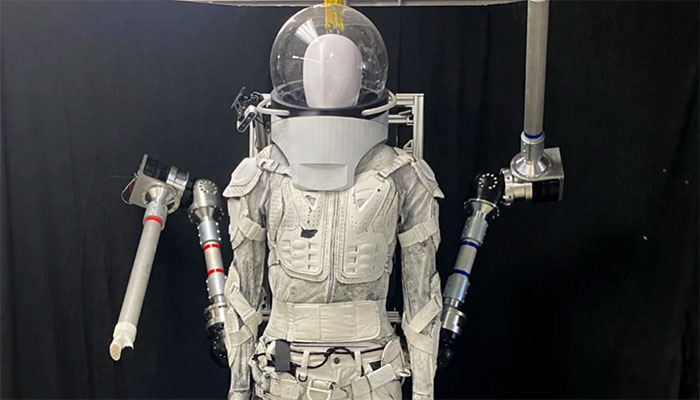'Super Limbs' invention helps astronauts stand firmly on the Moon
Scientists at the Massachusetts Institute of Technology (MIT) have invented 'SuperLimbs' that can help astronauts stand up when they fall.
According to a study by the University of Michigan, the Moon's gravity is only one-sixth of that on Earth, making it difficult for astronauts to maintain their balance. In the history of exploration, the 12 astronauts who participated in NASA's previous Apollo missions while walking on the Moon fell 27 times and nearly fell 21 more times.
When astronaut Charlie Duke fell on the Moon in 1972 while performing tests on the satellite, it took him three tries to get back up. Research has found that falls are more common when astronauts are collecting samples or using tools.

Two "extra limbs" on the back can help astronauts easily stand up when falling in low-gravity environments. (Photo: MIT).
Faced with the need for NASA to soon send humans back to the Moon and carry out unprecedented tasks such as building bases for humans or making long-term trips, for a decade, Harry Asada - a professor at MIT - has been thinking about the idea of a suit that can support astronauts when they fall . Since then, SuperLimbs was born.
According to Ana Diaz Artiles, an assistant professor of aerospace engineering at Texas A&M, equipping astronauts with two extra limbs in their backpacks to help them stand up could help astronauts save energy. In addition, lunar dust is "super toxic" so rolling on the surface of this satellite when astronauts try to stand up could be harmful to astronauts.
Erik Ballesteros, a graduate student at MIT who helped design the system, said the SuperLimbs system needs some further refinement, but he hopes it will be ready for use in January, when it will help a mannequin stand up from a prone position.
As the technology matures, Erik hopes the system will be ready for human use within a year or two, but the team has a lot to learn about safety first. 'We can't just tape things together; we have to be very precise and very careful ,' the researcher said.
There are other challenges the team could face, too. Dr. Jonathan Clark, a clinical professor of neurology and space medicine at Baylor College of Medicine who served as a crew surgeon on six NASA space shuttle flights, told CNN that the harsh environment of space — from temperatures, to particulate contaminants like dust, to electromagnetic radiation — could make approving the technology for use in space expensive and take years.
Besides supporting astronauts, Ballesteros said these extra limbs could help astronauts move faster, or the team is working to use them to support tasks such as excavation, sample processing, and construction.
In the history of space exploration, the Apollo 17 astronauts hold the record for the longest time spent walking on the Moon, at 7 hours and 37 minutes.
- Invention helps children with disabilities to walk normally
- What is super moon? When will Vietnam receive Super Moon?
- Photo: Manually watch the biggest moon in 20 years
- This weekend, we will see super moon
- Super moon shines all over the world
- Beautiful ghostly image of the last super moon in 2019
- Super moon images 2017 in the sky of countries
- NASA conducts a recruitment examination on the Moon, 1 against 1,300
- Let's admire the image of the last super moon of the year
- Super bright red moon in the sky of Spain
- Nice location for Vietnamese people to watch the super moon this century
- Photos: Super blood moon and blue moon all over the world
 Daily use inventions come from universities
Daily use inventions come from universities Special weight loss device helps prevent appetite
Special weight loss device helps prevent appetite 8 inventors were killed by their own inventions
8 inventors were killed by their own inventions Iran invented a motor car powered by water
Iran invented a motor car powered by water